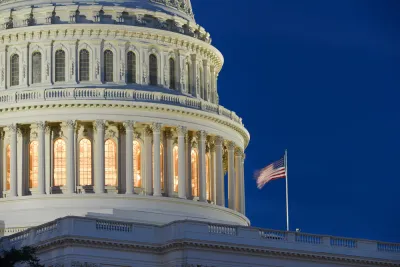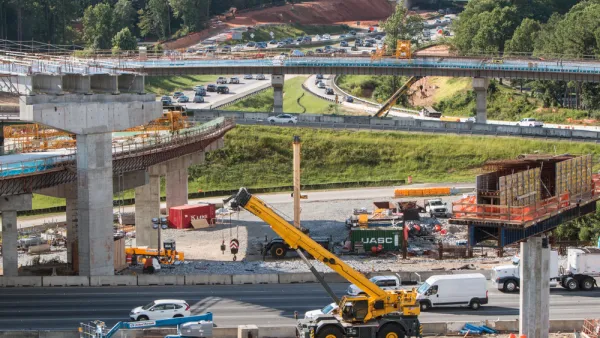Months after the Senate voted to approve the Infrastructure Investment and Jobs Act in a historic moment of bipartisan legislation, the House of Representatives put the finishing touches on a $1.2 trillion bill with $550 million in new spending.

You might have heard over the weekend that the House of Representatives passed the Infrastructure Investment and Jobs Act, but you probably still have questions about what that all means. The word infrastructure has been connected to multiple bills over months (years, really) of political back and forth, so it's hard to tell what's progress and what's a setback.
One fact is much more apparent than at any point since the Trump administration took office: Congress has finally approved a massive infrastructure spending bill—the only detail remaining for this historic legislation is the president's signature. Despite that new certainty, the media is likely to spend weeks and months figuring out the extent of what the news means for the country.
A relatively recent history informs an understanding of the scale of the achievement, and its potential consequences. Infrastructure planning and spending in the United States to this day occurs in the shadow cast by the economic stimulus programs of the Great Recession during the Obama administration—most notably with the American Reinvestment and Recovery Act of 2009 (ARRA). ARRA is frequently credited with leading the country from the largest recession since the Great Depression—infusing more than $830 billion into transportation, water and sewers, government buildings, energy, and other "traditional" forms of infrastructure. But ARRA also faced criticism from both sides of the political aisle. Complaints include achieving less economic benefit than possible because of the bill's focus on "shovel ready" projects, doubling down on the carbon economy and missing a chance to shift the country's infrastructure investments to a more economically sustainable and environmentally friendly model, and for delivering, in effect, a welfare bill rather than an economic stimulus.
Then came the Trump administration, which campaigned on a pledge to pass an enormous infrastructure spending bill—first promising a $500 billion plan before expanding the scale of that promise to spend $1 trillion without actually spending any money. The promises of the Trump administration, including numerous announcements of "Infrastructure Week" reduced the administration's ambitions to a punchline. When plans did show up, the president's own party did most of the damage to the cause, like in winter 2018 and again in spring 2019.
When the Biden administration's infrastructure ambitions repeatedly stalled—despite the political majority and the economic crisis seemingly required to propel a large spending package across the finish line—it smacked of "Infrastructure Week" all over again. The bill changed names, moved from House to Senate back to the House again, and got caught in the coattails of a large budget reconciliation bill that includes a huge investment in the social safety net. At this point, it's fair to wonder about the actual size of the final product; its relationship to earlier iterations, shorthands, and critical legislation included in the package (e.g., the American Jobs Act, Build Back Better, the INVEST in America Act, the Moving Forward Act, and the Bipartisan Infrastructure Framework to name a few); and how it compares to the original scope of the Biden administration's economic stimulus plans.
So let's start shining a light on the various corners of this historic shift in federal infrastructure spending. The final bill, authored by Rep. Peter DeFazio (D-Oregon), is titled H.R. 3684: the Infrastructure Investment and Jobs Act. With more political purposes in mind, the White House Twitter account referred to the bill as the Bipartisan Infrastructure Deal when announcing the bill's final approval in the House. The White House also published a Fact Sheet with more details on the final scope of the bill that split the difference and calls it the "Bipartisan Infrastructure Deal (Infrastructure Investment and Jobs Act)."
The focus of the Biden administration's communications seems to respond to some of the criticism of ARRA by focusing on the historic level of funding for programs that aren't merely new road building programs (although the amount of funding potentially available for new roads is still substantial). The Fact Sheet lists $89.9 billion in guaranteed funding for public transit over the next five years and $110 billion in additional funding to repair roads and bridges and "support major, transformational projects." The Fact Sheet also calls attention to investments in clean drinking water, high-speed Internet, airports, passenger rail, clean energy and energy efficiency projects, a national network of electric vehicle chargers, climate resilience, and Superfund and brownfield cleanup.
In more detail about the bill's potential to shift the nation's tradition of auto-centric transportation investments, the Fact Sheet touts the "single largest investment in repairing and reconstructing our nation’s bridges since the construction of the interstate highway system," the creation of the "first ever Safe Streets and Roads for All program to support projects to reduce traffic fatalities," "the largest investment in passenger rail since the creation of Amtrak," and "the largest Federal investment in public transit in history."
A few other key facts of note:
- The Infrastructure Investment and Jobs Act includes $550 billion in new spending as a portion of the larger $1 trillion figure cited in many headlines and articles about the final version of the bill.
- The Congressional Budget Office estimated the bill will add $256 billion to the deficit over the next 10 years.
- The final version of the Infrastructure Investment and Jobs Act is significantly smaller than the original Biden administration infrastructure proposal: $2.25 trillion for what was then called the American Jobs Plan.
- Approval of the Infrastructure Investment and Transportation Act includes approval of the Surface Transportation Reauthorization Act of 2021—the closely watched five-year legislative process sometimes referred to as the federal "Highway Bill."
- The INVEST in America Act, which would have enacted new controls on highways spending at the state level, was not considered as part of the version of the Infrastructure Investment and Jobs Act approved by the U.S. Senate in August, and is thus not included in the final, approved version.
- The social programs included in the Build Back Better Act are not included in the Infrastructure Investment and Jobs Act, as once seemed possible as part of a comprehensive budget reconciliation bill. Build Back Better is expected for a vote later this month.
To allow further digging into the details of the Infrastructure Investment and Jobs Act, Planetizen gathered all the news and commentary reported by the media so far (the House passed the Infrastructure Investment and Jobs Act at the least opportune time: in the final minutes of a Friday evening, so we can expect more news, commentary, and analysis throughout the week) for additional reading and deep dives into the moment. Planetizen will continue its coverage moving forward, so keep checking back with the Infrastructure Investment and Jobs Act tag and keep your eyes peeled news about the forthcoming Build Back Better showdown.
The Infrastructure Investment and Jobs Act, Explained
- Here's what's in the bipartisan infrastructure bill (CNN, November 5)
- House passes $555 billion infrastructure bill, sends legislation to Biden's desk (NBC News, November 5)
- Everything In The $1 Trillion Infrastructure Bill: New Roads, Electric School Buses, Great Lakes Restoration And More (Forbes, November 5)
- Fact Sheet: The Bipartisan Infrastructure Deal (WhiteHouse.gov, November 6)
- What’s in the Bipartisan Infrastructure Bill? From Amtrak to Roads to Water Systems [paywall] (Wall Street Journal, November 6)
- Roads, transit, internet: What’s in President Biden’s infrastructure bill? (Associated Press via WHYY, November 6)
- Infrastructure bill: $1tn for clean energy, internet, trains and more (BBC, November 6)
Special Interests
- Landscape Architects Poised to Lead New Era of Infrastructure (The Dirt, November 5)
- Infrastructure Bill Makes First Major U.S. Investment in Climate Resilience (The New York Times, November 6)
- Biden’s $1.2 Trillion Infrastructure Bill Hastens Beacons For Bicyclists And Pedestrians Enabling Detection By Connected Cars [paywall] (Forbes, November 6)
- Infrastructure bill funds urgent clean water and river restoration needs (American Rivers, November 6)
- The Infrastructure Bill: What’s In It For Us? (Streetsblog USA, November 7)
- Electric-Vehicle Charging Stations Win Jolt of Energy in Congress [paywall] (The Wall Street Journal, November 7)
- Infrastructure Bill Gives Biden Administration Greater Say Over Projects [paywall] (The Wall Street Journal, November 7)
- T4America statement on the passage of the 2021 infrastructure deal (Transportation for America, November 8)
Politics and What's Next
- House Passes Landmark Infrastructure Bill Despite Objections From AOC, Other Progressives (Rolling Stone, November 5)
- After months of setbacks, Biden finally gets long-sought win on infrastructure (The Washington Post, November 6)
- Biden gets his ‘infrastructure week,’ crossing another goal off Trump’s to-do list (The Washington Pot, November 6)
- Must Be Eliminated': Trump Republicans Vow to Oust GOP Members Who Voted for Infrastructure (Newsweek, November 6)
- With infrastructure victory in hand, Democrats brace for next battle over $2 trillion spending bill (The Washington Post, November 6)
- Lawmakers who bucked their parties on the $1T infrastructure bill (The Hill, November 6)
- In Infrastructure Votes, 19 Members Broke With Their Party (The New York Times, November 6)
- Pelosi Wins Infrastructure Bet, but Rest of Biden Agenda Still in Play [paywall] (The Wall Street Journal, November 7)
- Rep. Alexandria Ocasio-Cortez on the need to pass Build Back better for safe drinking water (Twitter, November 7)

Analysis: Cybertruck Fatality Rate Far Exceeds That of Ford Pinto
The Tesla Cybertruck was recalled seven times last year.

National Parks Layoffs Will Cause Communities to Lose Billions
Thousands of essential park workers were laid off this week, just before the busy spring break season.

Retro-silient?: America’s First “Eco-burb,” The Woodlands Turns 50
A master-planned community north of Houston offers lessons on green infrastructure and resilient design, but falls short of its founder’s lofty affordability and walkability goals.

Test News Post 1
This is a summary

Analysis: Cybertruck Fatality Rate Far Exceeds That of Ford Pinto
The Tesla Cybertruck was recalled seven times last year.

Test News Headline 46
Test for the image on the front page.
Urban Design for Planners 1: Software Tools
This six-course series explores essential urban design concepts using open source software and equips planners with the tools they need to participate fully in the urban design process.
Planning for Universal Design
Learn the tools for implementing Universal Design in planning regulations.
EMC Planning Group, Inc.
Planetizen
Planetizen
Mpact (formerly Rail~Volution)
Great Falls Development Authority, Inc.
HUDs Office of Policy Development and Research
NYU Wagner Graduate School of Public Service





























